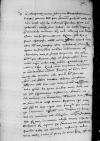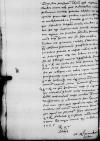List #1363
Johann REYNECK do Ioannes DANTISCUSKönigsberg (Królewiec), 1535-10-11
| odebrano [1535]-10-14 Rękopiśmienne podstawy źródłowe:
| ||||||
Tekst + aparat krytyczny + komentarz Zwykły tekst Tekst + komentarz Tekst + aparat krytyczny
Reverendissimo in Christo Patri et Domino, domino
Salutem et obsequiorum meorum plurimam commendationem.
cf.
Quod autem Suaeticus tractatus in consultationem
Meam causam illustrissimo domino  AAWO, AB, D. 4, f. 60v
AAWO, AB, D. 4, f. 60v
Morbus meus est, quem as<th>maticum vocent. Pulmones multa written over is⌈isaa written over is⌉ pituita obsidet, ut aegre hidden by binding⌈[e]e hidden by binding⌉ spiritum permitta written over i⌈iaa written over i⌉t, quibus resolutis pharmacis mollificantibus succedit gravis tussis, quae difficilius conceptum virus eructat. Inter ista ego diuturnitate morbi exhaustus agitor, ut succedat febrilis paroxysmus orig. parasismus⌈paroxysmusparoxysmus orig. parasismus⌉ super horas XII. In his malis luctor, ut gravius enitar saniem, quam
cf. Adagia 1382 Echinus partum differt ⌊e{s}chinus parturienscf. Adagia 1382 Echinus partum differt ⌋, profluit autem perpetua pituita a capite, veluti a fonte et sсaturigine, atque ita laboro, ut mihi sit ad
Quare hidden by binding⌈[e]e hidden by binding⌉, si Gratia Vestra Reverendissima me consilio suo litteris iuvare digna hidden by binding⌈[a]a hidden by binding⌉bitur, fieret desiderio meo satis. Nam Deus scit, cum colloquii erit nobis copia. S... illegible⌈...... illegible⌉, quid
Ceterum, Reverendissime Domine, habet Gratia Vestra Reverendissima et ipsa balsamum verum, si dignaretur hidden by binding⌈[tur]tur hidden by binding⌉ hoc vitriolum plenum mihi impartiri ad bonam valetudinem, mihi multum commodaret, praesertim, si celerrime per hunc suum meo equo, qui apud vos est, illud mittet, ad reditum recepturus hunc vestrum hidden by binding⌈[vestrum]vestrum hidden by binding⌉, qui apud me servatur.
His commendo me hidden by binding⌈[me]me hidden by binding⌉ Reverendissimae Gratiae Vestrae.
Salutat Gratiam Vestram
Ex
Reverendissimae Gratiae Vestrae deditissimus


